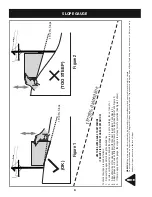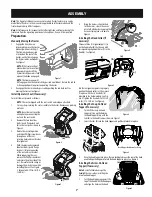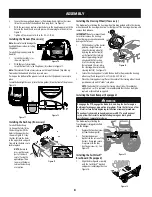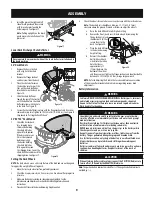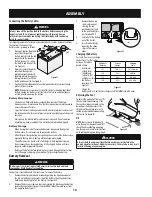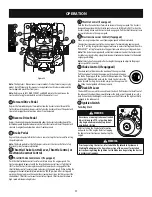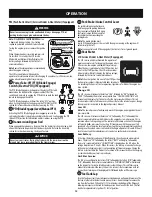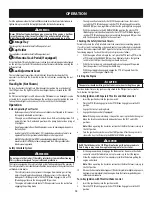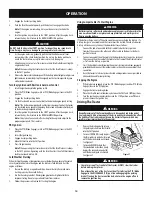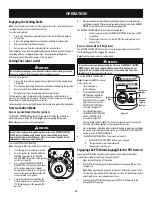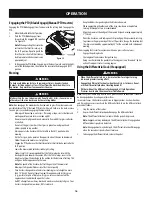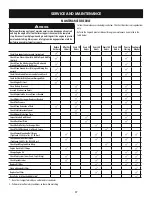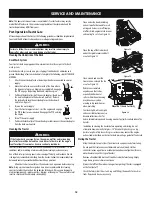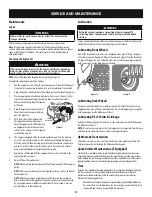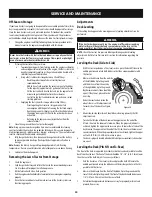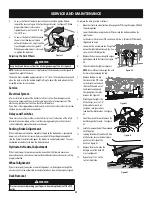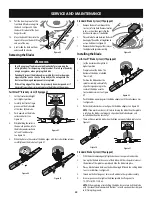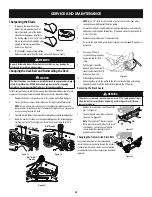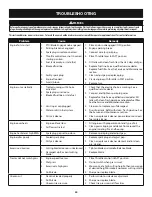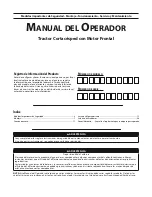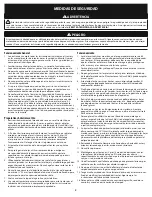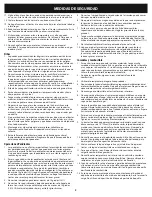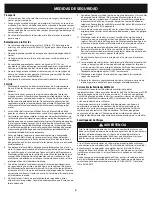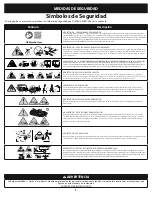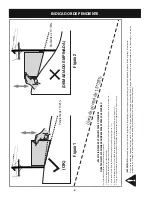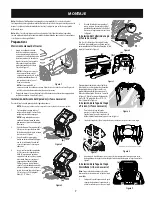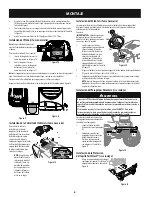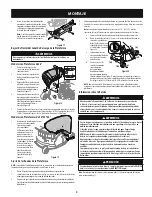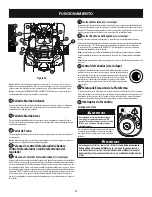
20
SERVICE AND MAINTENANCE
Off-Season Storage
If your lawn tractor is not going to be operated for an extended period of time (thirty
days to approximately six months), the lawn tractor should be prepared for storage.
Store the lawn tractor in a dry and protected location. If stored outside, cover the
lawn tractor (including the tires) to protect it from the elements. The procedures
outlined below should be performed whenever the lawn tractor is placed in storage.
1.
Change the engine oil and filter following the instructions provided in this
manual as well as the engine manual provided with this tractor.
WARNING
Never store the tractor with fuel in the tank indoors or in poorly ventilated
enclosures, where fuel fumes may reach an open flame, spark or pilot light
as on a furnace, water heater, clothes dryer, etc.
2.
If storing the tractor for 30 days or more:
a.
To prevent gum deposits from forming inside the engine’s carburetor
and causing possible malfunction of the engine, the fuel system must
be either completely emptied, or the gasoline must be treated with a
stabilizer to prevent deterioration.
b.
Using a fuel stabilizer for storage between 30 and 90 days:
•
Read the product manufacturer’s instructions and
recommendations.
•
Add to clean, fresh gasoline the correct amount of stabilizer
for the capacity (approximately 3 gallons) of the fuel system.
•
Fill the fuel tank with treated fuel and run the engine for 2-3
minutes to get stabilized fuel into the carburetor.
•
Fuel left in the fuel tank deteriorates and will cause serious
starting problems.
c.
Emptying the fuel system for storage of more than 90 days:
•
Prior to putting the tractor in storage, monitor fuel
consumption with the goal of running the fuel tank empty.
•
Run the engine until it begins to stall. Use the choke to keep
the engine running until all fuel in the carburetor has been
exhausted.
•
Referring to the engine manual, drain the fuel from the
carburetor bowl.
3.
Clean the engine and the entire tractor thoroughly.
Note:
Using a pressure washer or garden hose is not recommended for cleaning
your tractor other than to clean the underside of the deck. It may cause damage to
electrical components, spindles, pulleys, bearings or the engine. The use of water will
result in shortened life and reduce serviceability.
4.
Fully charge the battery, then disconnect the negative cable at the battery
to prevent possible discharge. Recharge the battery periodically when in
storage.
Note:
Remove the battery if exposed to prolonged periods of sub-freezing
temperatures. Store in a cool, dry location where temperatures are above freezing.
5.
Lubricate all lubrication points.
Removing the Lawn Tractor from Storage
1.
Check the engine oil.
2.
Fully charge the battery and inflate the tires to the recommended pressure.
See tire side wall for proper tire inflation pressure.
3.
Fill the fuel tank with clean, fresh gasoline.
4.
Start the engine and allow to idle for a few minutes to ensure engine is operating
properly.
5.
Drive the tractor without a load to make certain all the tractor systems are
functioning properly.
Adjustments
Deck Leveling
If the cutting deck appears to be mowing unevenly, leveling adjustments can be
performed.
WARNING
If the tractor has been recently run, the engine, muffler and surrounding
metal surfaces will be very hot and can cause burns to the skin. Let the
engine cool for at least five minutes. Exercise caution to avoid burns.
NOTE
: Check the tractor’s tire pressure before performing any deck leveling
adjustments. Refer to Tire Pressure in this section for information regarding tire
pressure.
Leveling the Deck (Side-to-Side)
1.
With the tractor parked on a firm, level surface, place the deck lift lever in the
middle position and rotate both blades so that they are perpendicular with
the tractor.
2.
Measure the distance from the outside
of the left blade tip to the ground
and the distance from the outside
of the right blade tip to the ground.
Both measurements taken should be
equal. If they’re not, proceed to the
next step.
3.
Under the rear fenders inside the
wheels there is a lift adjustment rod
for each side of the deck. See Figure
38.
4.
Minor side-to-side adjustments should be made using primarily the left
adjustment rod.
5.
To raise the left side of the deck, loosen the upper nut on the end of the
lift rod, then turn the lower nut clockwise. When the proper adjustment is
achieved, tighten the upper nut to secure in place. To lower the left side of the
deck, loosen the upper nut on the end of the lift rod, then turn the lower nut
counterclockwise. When the proper adjustment is achieved, tighten the upper
nut to 25-30 ft-lbs (34-40 N-m) to secure in place.
6.
The deck is properly leveled when both blade tip measurements taken earlier
are equal.
Leveling the Deck (Pitch/Front-To-Rear)
The front of the deck is supported by a stabilizer bar that can be adjusted to level the
deck from front to rear. The front of the deck should be 1⁄4”-3⁄8” (6.35-9.5mm) lower
than the rear of the deck. Adjust if necessary as follows:
1.
Park the tractor on a firm, level surface and place the deck lift lever in the
middle position and rotate the blade nearest the discharge chute so that it is
parallel with the tractor.
2.
Measure the distance from the front of the blade tip to the ground and the
rear of the blade tip to the ground. The front of the deck should be between
1⁄4”-3⁄8”(6.35-9.5mm) less than the rear of deck.
3.
Determine the approximate distance necessary for proper adjustment and
proceed, if necessary.
Figure 38

